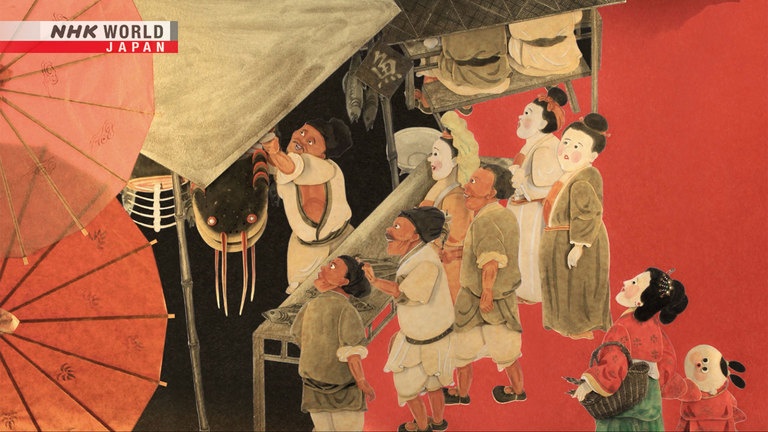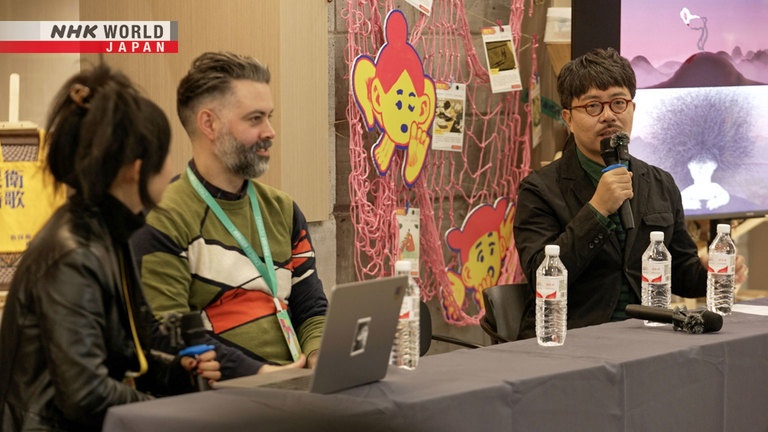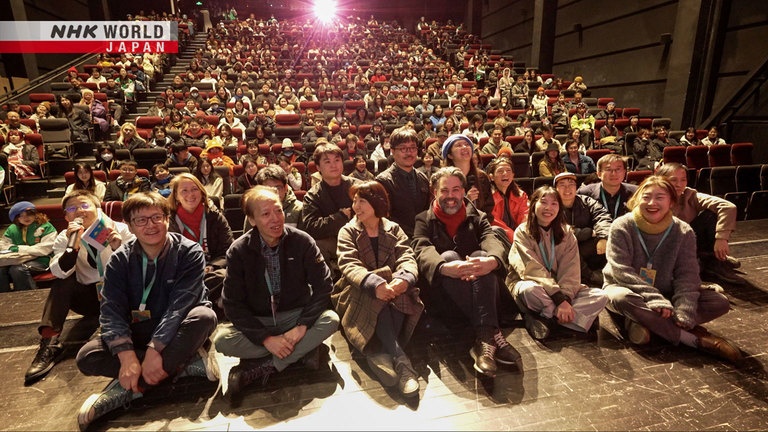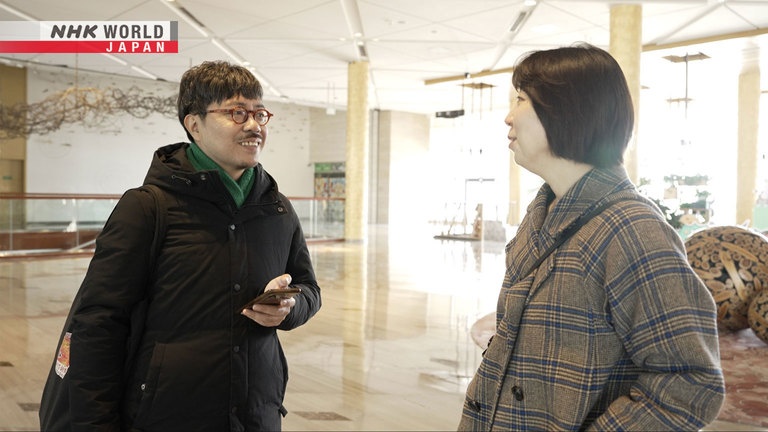Animation as an Anti-Anxiety Therapy: Chen Lianhua / Independent Animation Filmmaker
Independent animation creator Chen Lianhua describes his creative philosophy as indie animation gains new attention in China, where such programs have gathered major viewership.




Transcript
Direct Talk
China's animation industry is
in the midst of a great change.
In 2023, a project was unveiled to
commemorate a century of Chinese animation:
an eight-episode series of shorts
called "Yao-Chinese Folktales."
11 animators worked together on the program
using diverse and
unique methods to bring life
to Chinese tales of the supernatural.
In just one month,
it gained over 200 million views.
A popular favorite in the series is director
Chen Lianhua's "Ship Down the Well."
Its mixture of traditional
Chinese art and paper cuttings
filmed with stop motion
earned acclaim for its nostalgic style.
While respecting tradition,
rather than totally copy that,
I'd like to use it to new means.
If Chinese culture is
to become popular in the future,
I think an effort like that will be needed.
Chen Lianhua uses revolutionary
animation techniques
to breathe life into the Chinese classics.
In this program,
we delve into the secrets of his work.
Animation as an Anti-Anxiety Therapy
November, 2023.
Drawing its name from the invention that
realized early animation, the phenakistiscope,
the Feinaki Animation Week
was held in Beijing.
Welcome to the
Feinaki Short Animation Competition.
Chen is one of the founders of the event,
which was first held in 2018.
In 2000 he began working
as an independent animator,
creating a total of 14 short films
such as "The Winter Solstice,"
"The Swallow," and "The Six."
Mastering subjects and techniques
from traditional Chinese storytelling,
his works appealing to universal
human emotion drew strong praise.
In 2023, he unveiled his latest work,
"Ship Down the Well."
The name of the main character, Xiaoman,
refers to May 21st on the Chinese calendar,
which is believed to be the start
of great growth and fulfillment.
"Ship Down the Well" uses
traditional paper-cutting techniques,
but it actually employs a variety of methods.
When the children enter the house,
they go from small to large.
We combine these two realms into one frame.
When the children take
Xiaoman through the screen,
he's laid out in bed.
Logically, after they enter the screen,
you expect them to leave it.
This expresses the change in time:
Two times coexist within one space.
There's an ancient
Chinese picture scroll called
"The Night Revels of Han Xizai"
that uses the same motif.
He appears five times
representing different times.
In the center is a screen,
indicating a different area.
Positioning a different time and space
within the same image
was actually very common
in classical Chinese painting.
In deliberately
adding paper-cutting animation
to the traditional composition
of picture scrolls,
Chen faced an extremely
difficult production process.
The method for paper-cutting animation is
very involved, and when wet, it shrinks a lot.
One day it started raining
so we went back after filming half,
and the next papers were
curled up and unusable.
We finally were able to
get them to work with a dryer,
but it was almost a total waste.
After an entire year
and a half in production,
"Ship Down the Well" was released
to rave reviews from viewers of all ages.
300 million plays
I was surprised to see
"Yao-Chinese Folktales" get so much attention.
After all,
we created it not as a crowd-pleaser,
but a work of self-expression.
I think that more and more,
unusual and individual works
will become noticed.
The main reason is the economic reform.
China's becoming more open,
and it isn't something that will be reversed,
so the result is people
holding much broader viewpoints.
Chen took an interest in animation
during his first year of elementary school.
At the time,
the Chinese reform and opening-up
brought a wave of
foreign animation to television.
I became a huge fan,
and a bond was formed.
I believed that I had to be an animator,
and that a fun life would be in store for me.
He published a four-panel manga
in a young artists' magazine at the age of 11,
and by the time
he graduated elementary school,
he was drawing four different series.
While he loved writing manga,
he had another pursuit that
he picked up at his father's urging:
Calligraphy.
My father was skilled at calligraphy.
I feel there's a connection
between calligraphy and animation,
but no one had ever pointed it out to me.
Learning calligraphy,
there's a focus on "form and spirit."
It's hard for children to grasp,
but it means that a single letter
has a shape, a spirit,
a stroke, and a space.
The trademark of Liu Gongquan
was his fine, powerful strokes,
combining a beauty and strength.
Each one seems to have been
almost carved by a knife.
For comparison, this is Yan Zhenqing.
His characters are very thick,
elegant, and powerful.
One glance tells you
he was no frivolous nouveau riche.
The strokes are abundant,
laterally light
but vertically thick, with contrast.
Letters convey various impressions.
Learning calligraphy from a young age,
I would imagine the expressions
and mannerisms of people as I wrote,
and it became a sort of training for me.
That was probably the aspect of it
that affected me most.
Chen eventually advanced to university,
where he studied administrative management,
taking a leave from the world
of manga and animation.
But after graduating and experiencing
a few different kinds of work,
he felt art calling him again.
A few years later, a life event
would change his way of thinking:
the birth of his first child.
Before my son was born,
I hadn't really looked back or
taken notice of my childhood experiences.
But after that, as I watched him, I began to
remember my experiences from that time.
For example, the book "Bear Grandmother."
It was a book published in the 1970's,
about a little girl and her younger brother.
When the adults weren't around,
a black bear would pretend to be
their grandmother and sleep in her bed.
They were terrified of it.
The scariest scene was when the bear
is stabbed in its mouth with a spear,
killing it with blood gushing out.
That scene freaked me out as a kid so much
that just the cover of the book scared me.
It was a traumatic experience.
Looking at children,
I realized that little things
that happen in their childhood
have major effects on their growth.
The "shadow of childhood," in a sense.
I wanted to illustrate
a work relating to that.
That's how I decided
to convey a children's story
using the traditional method of prints,
and settled on "Ship Down the Well."
When I went to an exhibit
at the Forbidden City,
a young man was telling
a young woman about the works,
and I identified with what he said.
He was talking about a literary painting.
Many paintings and calligraphies
by classical artists
were written with a sense of playfulness,
but came to be prized
as the pinnacle of classical work.
That's how creation is,
in that everyone is serious about their work,
but it all begins from a feeling of interest.
By relaxing and feeling excitement,
the works you create
are teeming with that vitality.
Chen is currently teaching
a university course on animation
in order to contribute
to the next generation.
Coming in contact with young
animators-to-be, he realized something.
Students who study animation
tend to share one trait:
Many of them aren't very outgoing.
Watching animation is an outlet for them,
and they go on to become animators.
I think that's especially true
for people who create artistic animation.
More outgoing people would pursue
a different kind of animation,
or maybe make movies instead.
Self-expression is more useful
in self-healing than it is in making money.
Even if it doesn't earn much, people want to
express themselves and feel relief.
At least, that's how it was for me.
I can't live without animation,
so if I'm not at work on something,
I'll start to feel anxious and down about it.
Then when I begin work,
the world is beautiful.
Creativity has a sort of addictive,
medicinal effect like that.
That's my true motivation,
one that goes far beyond
things like interest or self-expression.
In 2018, Feinaki Animation Week
began its annual shows.
Now in its fifth year,
the event has attracted 699 works
from 42 countries and regions,
with 136 short animations shown
over the course of 4 days.
Chen's ultimate goal with the event was to
help animators often subjected to solitude
by showing them the excitement
of creativity and social exchange.
When I had made a work before,
I wondered if anyone could possibly
understand it, or take a liking to it.
By taking part in
a lot of animation festivals,
I discovered the importance of how animation
can transcend language and culture.
Our animations have very few spoken words,
but people can understand them,
and enjoy them.
If someone far off in the world
can understand and enjoy my works,
then I feel a bond with them.
By stimulating traditional Chinese culture
through the means of animation,
Chen hopes to relieve
the internal anxiety that people share.
This goal is reflected in his motto.
When I was in middle school,
I first read Japanese manga.
It was the story of a doctor of western
medicine active during the Meiji Restoration.
Before he passed away, he said that he
wanted to "make a boring world interesting."
I was inspired by that,
and it's become a sort of motto for me.
As hard as life is,
that makes fun all the more important.
Even in the best of times,
the world is a boring place.
By making a boring world
even a little more interesting,
I think we make a huge
contribution to the world.